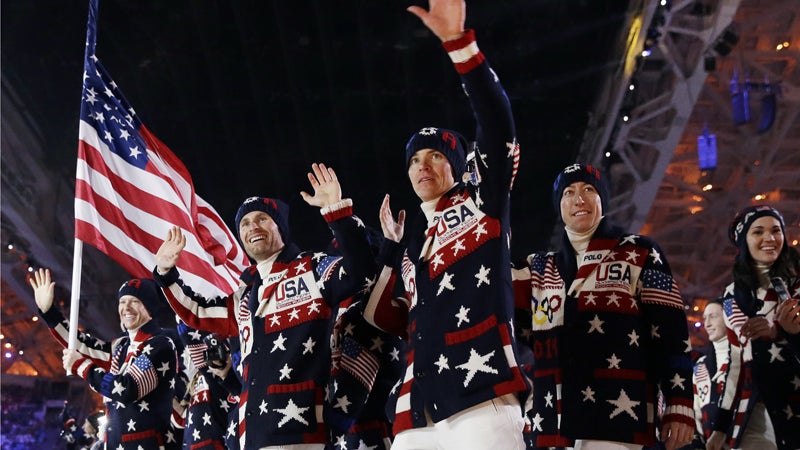The official opening ceremony sweaters by Ralph Lauren—love them, hate them, or employ them in lieu of a stomach pump—are famously sourced, spun, dyed, and knit in the United States. It’s a feel-good moment for those who care about Made in America labels and retaining stateside manufacturing jobs. But, as the Sochi Potemkin Village is to Russians, the sweater is just an excuse to wrap ourselves in the illusion of patriotism—and the charade of insourcing.
Today, almost all our apparel—including the technical, waterproof-breathable shells and downy insulators we covet—is manufactured in Asia, or at least outside the U.S. Less than two percent of all the apparel purchased here annually is made in this country. One could argue (successfully) that sometime in the last 30 years, we as a nation lost many of those jobs to globalization, cheap goods, supply chain economics, and so-called free trade—which too often means sweatshop labor.
“The Ralph Lauren sweaters are just an excuse to wrap ourselves in the illusion of patriotism—and the charade of insourcing.”
But that’s not the case with manufacturing outdoor gear—the skis, snowboards, boots, bindings, helmets, goggles, body armor, and even speed suits helping Bode Miller and Mikaela Shiffrin in Sochi. We didn’t lose those jobs because we never had them. Or at least not many of them.
Take the Spyder-branded speed suits the U.S. Ski Team is wearing this week. The high-tech uniforms are produced by a Swedish-owned company in Poland. It’s one of a handful of such manufacturers, almost all of which are European-based. “The guy who started the company was a ski racer in the 1980s,” says Barry Levinson, co-president of the Colorado company SRD, or Ski Racing Development, which also contracts with the factory for suits. “Financially it would be impossible to try to do it here. Actually, I can’t think of one piece of equipment that an Olympic ski racer will be using that’s made in the U.S.”
With a few notable exceptions— were once made in Washington but are now pressed in Asia—Europe has a stranglehold on the production of high-end skis and boots. There are a few reasons for this, including government subsidies that float ski companies during lean years and in return demand continued employment. Then there are Europe-based feeder companies that make the edges, sidewalls, base materials, and cores so manufacturers don’t have to warehouse goods or incur the cost of long-distance shipping. But the real reason Europe reigns when it comes to making ski gear is institutional knowledge. Read—the people.
“I can’t think of one piece of equipment that an Olympic ski racer will be using that’s made in the U.S.”
Last week at the ski show in Denver, I met a Frenchman named Eric Bobrowicz (he goes by Bob), a master ski shaper who recently launched the small ski company . “Master ski shaper” is a credentialed title in Europe. Bob earned it after spending 40 years making skis for big brands like and . In this country, anybody with a CNC machine, a ski press, and some glue can make a pair of sticks that look like skis, but finding the balance between torsional rigidity and longitudinal flex takes a lot of experience. Get it wrong and the skis don’t feel supple, buttery, and powerful—they feel like planks. Bob’s skis aren’t planks.
There are people like Bob throughout Europe. And companies take advantage of that human capital. A few years ago, 91-year-old shifted its entire production of skis back to Germany. Prior to that, many of its fatter skis were being built in Asia. And guess what? We actually noticed the bump in quality at our annual ���ϳԹ��� and Mountain magazine ski test in Snowbird, Utah. The ��ö����� reps in the U.S. tell me that there are multiple generations of families working in the German factory.
The ski boot business is even more familial and cloistered. I’ve visited the northern and Asolo where alpine brands like Tecnica, Nordica, Salomon, Atomic, Lange, Rossignol, Dalbello, and backcountry brands like Scarpa and Dynafit lovingly craft boots. Almost the entire ski boot business can be found in these two European enclaves. Prior to making ski boots, the sister towns were known for the production of high-end hiking boots—a tradition that’s continued non-stop since the 1600s. Yes, they’ve been hand-shaping lasts—the foot shaped form boots are built around—for more than 400 years. Today, if you need a trustworthy buckle or a specific variety of urethane or Pebax for the boot you’re designing, you’ll find it far easier to source in Montebelluna than in Asia. If you can get it outside the country—the Italians don’t take kindly to outsourcing ski boot jobs.
All of this centers around a common theme—U.S. innovation and European execution. Bob Lange invented the plastic ski boot in the U.S. in the 1960s. But it was Nordica that figured out how to properly inject molds. So Lange sold his company to the Europeans who had a better handle on production.
Switch Europe for Asia in that last sentence and it sounds like we’re talking about tech. But with skiing this is ancient history. Another prime example is Head. Most of the upcoming race podiums will go to skiers on Head skis. Howard Head was an American aircraft engineer and skier who invented the first metal laminate ski in 1947. Racers are still skiing on U.S.-invented metal laminate skis, but for most of its history, Head has been an Austrian brand.
Gore-Tex jackets, double lens goggles, snowboards, chairlifts, fat skis, rockered skis, all U.S. inventions, aren’t coming from U.S. factories. As , “They don’t make nothing here no more.”
But don’t despair just yet. Because beneath that Italian ski boot you’ll find the one Made In America item I can guarantee you our star skiers are wearing right now. —the official supplier to the U.S. Ski Team, and way nicer looking than those ridiculous sweaters.


